
JANE BURN – POETRY AS HARD GRAFT, INSPIRATION, REACTION OR EXPERIMENT?
I interviewed poet & artist Jane Burn who won the Michael Marks Environmental Poet of the Year 2023-24 with A Thousand Miles from the Sea.
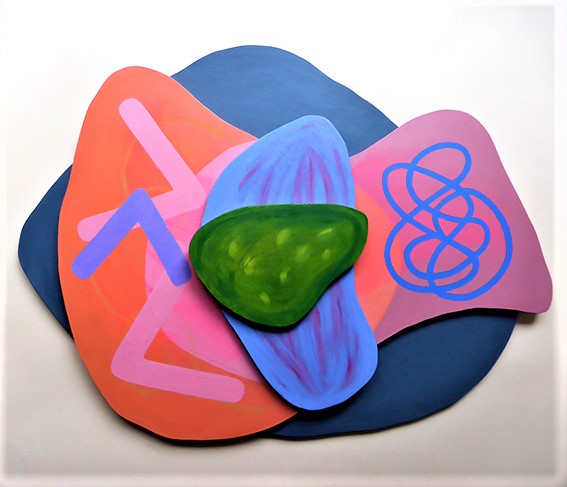
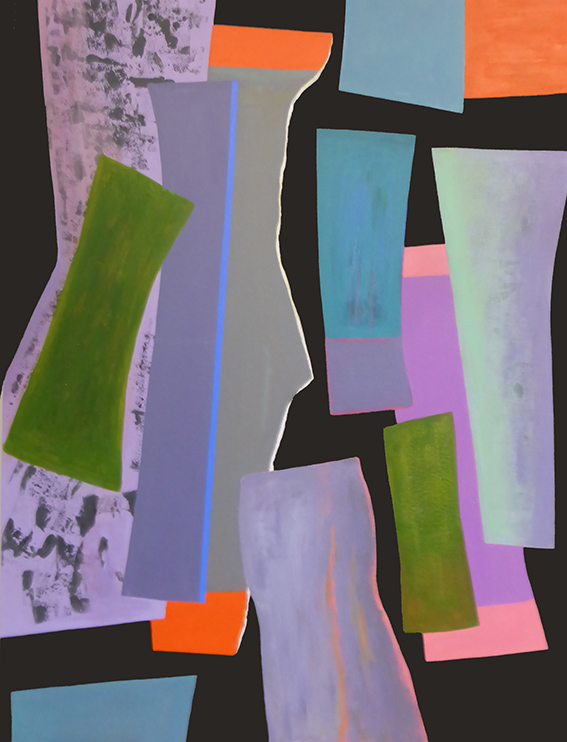
I interviewed abstract artist Annabel Ossel about how she creates her multi-coloured art in several different mediums and how her pieces link together. Annabel’s first career was as a picture researcher, where she developed the practical skills of researching (or sourcing) images for books and other media. But then she began to paint and exhibit her work, recently taking a Masters in Fine Art, and became the highly-expressive, innovative artist she is today. This is her story.
Leslie: Can you describe your artistic process, please, mentioning what kind of art it is while giving us an insight into how you create, from first spark, through development stages into finished pieces.
Annabel: I would call myself an abstract artist. My work could be described as hard-edged, as I tend to use blocks of colour, but I also include transparent layers and mark- making. By arranging seemingly unconnected shapes and colours in different configurations I create paintings, collages, or other work. Whilst figurative art re-presents recognisable subjects, and some figurative or even abstract work is about ideas, experiences or memories, my work is mainly about itself, that is, shapes and colours applied to a flat surface which have no connection to my life or experiences, or at least not consciously so. What is important for me is primarily the colours I use, the way the shapes and colours interact, their size and positioning on the surface. I aim to create a dynamic that induces some kind of emotional state. But as all art is subjective, for the artist and the viewer, it’s difficult to know the effect of the overall work on different people, based only on my own reactions.
I rarely create anything from scratch. Each work tends to lead onto another, or several other, works, not necessarily in the same medium. So the more work I produce, the bigger the repository of images and ideas I can draw from. As I keep extensive photographic records of different stages of my work, I can look at what I’ve produced, either recently or even several years before, and create something new that may not have any visible resemblance to its progenitor.
I do have a basic system of working. The first stage involves observation and contemplation. Ideas might come in dreams or the odd Eureka moment whilst walking, having a shower or doing other non-artistic things. As well as looking at past work, I often use PhotoShop to make a few “sketches” or just play around. I find this helps me to quickly develop the basis for a new work. Another more hands-on approach is to move pieces of coloured paper around on a surface. Whichever way I start, the initial composition will usually change dramatically. A finished work can sometimes suggest a theme or seem to be a metaphor for something unrealised at its inception. The titles I give my works, which are usually random, but somehow appropriate, seem to enrich them.
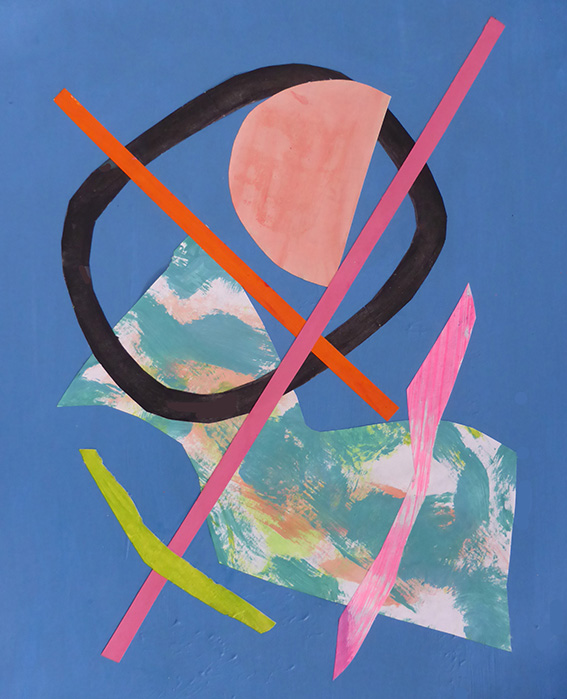
Leslie: You create collages, paintings and prints using various processes. What’s the artistic and practical transfer between your work in these different mediums?
Annabel: All my work, in whatever medium, is linked in some way. For example, I create collages from bits of painted paper using left over acrylic paint from painting pictures, so there’s an immediate connection between the two mediums and a continuity in the use of certain colours or shapes. Sometimes I create a painting based on a collage.
My digital prints are made by superimposing two or more photos of different works and varying the transparency of one or both, which produces a new and unexpected image. It could be a painting and a collage, or two paintings together, and so on. The combinations are infinite. I create the images in a PhotoShop app and then refine them further in the standard PhotoShop to make the quality good enough for printing. I printed them myself during my MA course, when I had access to a digital printer at the University of Hertfordshire. As I was able to manipulate the images almost while I was printing, it meant being able to control the colours. I also use more traditional forms of printing such as screenprinting, which is more time-consuming but very rewarding as results are also unpredictable. But rather than producing a series of identical prints I tend to end up with a variety of monographs to which I might add touches of acrylic or collage pieces.
The wooden pieces are a fairly new departure and a very exciting leap to be working in a third dimension. I started doing these during my MA course, when I discovered large bins full of off-cuts. Being focussed on colour, I painted the random pieces of wood which I then assembled into compositions that are reminiscent of my paintings and collages. I now cut out my own increasing larger pieces of wood and my process is a bit less haphazard. I have also made 3D pieces from discarded plastic.
Leslie: Looking back, what’s the story of the various milestones that have led you to becoming an artist?
Annabel: Although I briefly went to art school in my early twenties, I was not committed enough and was put off by the classical approach of the art school. Subsequently, my only connection to the art world was visiting exhibitions and doing the odd collage or doodle. When I became a picture researcher I worked on quite a few art books so became familiar with the work of certain artists but without having a good overview of the historical contexts in which their work was produced. My curiosity led me in my forties to doing a BA in History of Art. I learnt that artists, even abstract ones, do not live and practice in a vacuum but are a product of their environments, education, cultural and social environments.
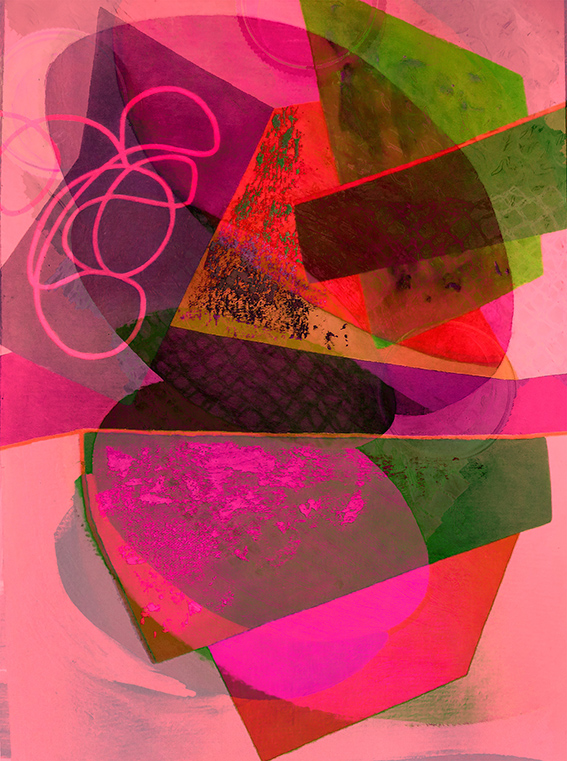
In 2005 I exhibited a series of stripe paintings at a local art fair. This was the beginning of my career as an artist. Then in 2012, I joined the Eagle Gallery, a cooperative gallery in Bedford. This gave me a sense of being accepted as an artist, as well as the support of fellow artists and most importantly, the motivation to produce work for the monthly group exhibitions and occasional solo shows. But gradually I felt that my work was stagnating and was constrained by what was commercially viable. I realised that I needed a fresh impetus so I took the plunge and did a Masters in Fine Art two years ago. This proved to be a very good decision as it opened up my work to new possibilities and made me more courageous in realising ideas and attempting new techniques. It also taught me how to be critical of my own and other artists’ work and to be more articulate in my thinking and writing about my practice.
Leslie: What did you do as a picture researcher, what were the things you learned to look out for when doing the job? What else did you learn from the job?
Annabel: Basically, as a freelance picture researcher I sourced images for books, magazines, websites and other media. These were mostly single projects except when I worked on the Observer Magazine for two years and then a further two on Woman. The client would provide a list of the required subjects or I might have to read a book to make my own illustrations list. Although I gravitated towards art and history subjects, I also covered an eclectic range of subjects. Some requests were very challenging if not impossible, like getting hold of a photo of the Big Bang! From celebrities to natural history, science and other educational subjects. I would find the majority of images from picture libraries, ordering them by phone or visiting and researching myself. Other sources were museums, companies, government departments and personal archives. Sometimes I would go further afield. For example, to Crewe to trawl through archives for a book on the Bentley marque or to Cardiff for a new children’s’ museum.

The downside was all the admin involved. At first photos were analogue and were sent out on loan. They had to be carefully tracked and if selected for use they needed to be cleared for reproduction rights and copyright. As images became digitised in the late nineties, they became accessible online and in theory it became possible for anyone to source images. For me it also meant a decline in human contact and an increase in scrolling through endless images on a computer screen. But looking at hundreds of photos on a daily basis, apart from addling my brain, sharpened my observational and compositional skills, as well as teaching me how to edit down to the essential. All this would later benefit my art work.
What did I learn? The camera often lies – or tells alternative stories. Cropping is a very important tool in order to omit extraneous information and highlight what is necessary. I still “crop” my own work or things I am looking at to get a better compositional sense. I came into contact with a lot of photographers, some of them very talented, so I learnt about commissioning photography as well as sourcing existing material. Although I became interested in being a photographer, I came to the conclusion that photography was a highly competitive field. Now I’m finding it’s the same thing in the art world!
Leslie: Who are the most important influences on you? Why them?
Annabel: Narrowing down to three influences is impossible. The artists who influenced me were, not surprisingly, those who use or used colour extensively as part of their practice: Matisse, Rothko, Gillian Ayres, Howard Hodgkin, John Hoyland, Bridget Riley, Katherina Grosse, Mali Morris, Frank Stella, to name a few. But if I had to single out one person I would say that it was my mother who was my first big influence because she inculcated in me an awareness and appreciation for colour.
She studied textiles at Central School of Art and later designed clothes for children. When I was growing up, our flat was full of colour: the hallway and my bedroom were tomato red, the kitchen was bright blue and another room green. Later on, I decorated with a bold palette in my own homes. My father was a sculptor whose work was both abstract and figurative. I would like to think that he influenced me – possibly because of the shapes I use – but he was not around when I was growing up and I was not exposed to his work until I was an adult.
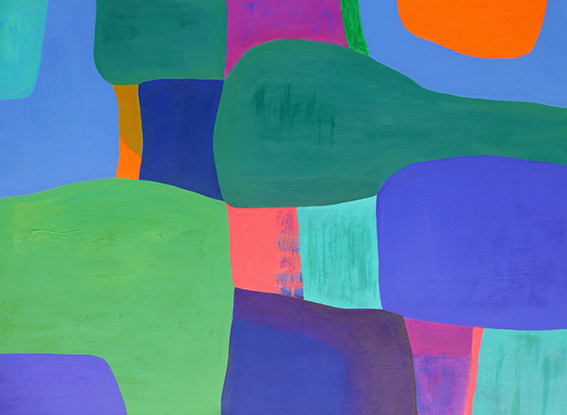
Leslie: Why do you work as an abstract artist, rather than other forms of representational art?
Annabel: I have great admiration for artists who can skilfully represent the world around them – especially those who have developed their own distinctive style. But figurative or representational art doesn’t interest me. I find the real world distracts from my practice and the technical skills needed in trying to depict aspects of it would prevent me from having the freedom to create what I want. Of course I am influenced by the world around me, but I think that perhaps my work reflects a certain unconscious distancing from it.
Whilst I do sometimes get frustrated at not being able to express in my work various issues that concern me, such as the climate emergency or Brexit, I compensate for this by the titles I give to my work. Titles can actually be the most difficult part of the creative process but they satisfy my love of playing with language – hence my website, Iconos, which combines the Greek term for picture and part of my surname. But until I find a more direct way to shout about things I will just carry on abstracting.
Next week I interview poet and short-story writer Nora Nadjarian, who writes about women, refugees, identity, exile, love and loss, as well as the political situation in Cyprus.
ABOUT LESLIE TATE’S BOOKS:

I interviewed poet & artist Jane Burn who won the Michael Marks Environmental Poet of the Year 2023-24 with A Thousand Miles from the Sea.

I interviewed ex-broadcaster and poet Polly Oliver about oral and visual poetry, her compositional methods, and learning the Welsh language. Polly says, “I absolutely love

I interviewed Jo Howell who says about herself: “I’ve been a professional photographic artist since I left Uni in 2009. I am a cyanotype specialist.


Poet Tracey Rhys, writer of Teaching a Bird to Sing and winner of the Poetry Archive’s video competition reviews Ways To Be Equally Human. Tracey,
| Cookie | Duration | Description |
|---|---|---|
| cookielawinfo-checkbox-analytics | 11 months | This cookie is set by GDPR Cookie Consent plugin. The cookie is used to store the user consent for the cookies in the category "Analytics". |
| cookielawinfo-checkbox-functional | 11 months | The cookie is set by GDPR cookie consent to record the user consent for the cookies in the category "Functional". |
| cookielawinfo-checkbox-necessary | 11 months | This cookie is set by GDPR Cookie Consent plugin. The cookies is used to store the user consent for the cookies in the category "Necessary". |
| cookielawinfo-checkbox-others | 11 months | This cookie is set by GDPR Cookie Consent plugin. The cookie is used to store the user consent for the cookies in the category "Other. |
| cookielawinfo-checkbox-performance | 11 months | This cookie is set by GDPR Cookie Consent plugin. The cookie is used to store the user consent for the cookies in the category "Performance". |
| viewed_cookie_policy | 11 months | The cookie is set by the GDPR Cookie Consent plugin and is used to store whether or not user has consented to the use of cookies. It does not store any personal data. |